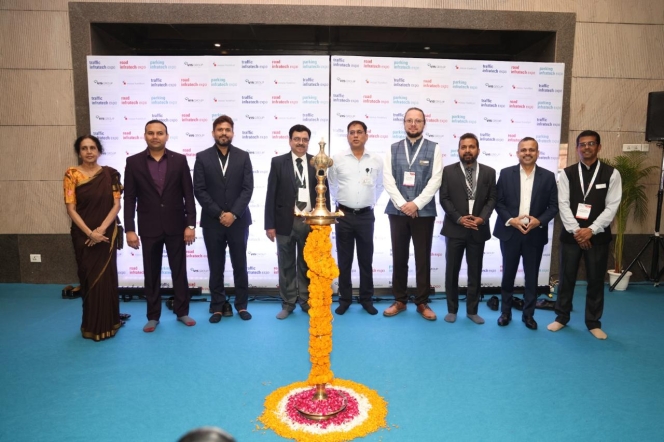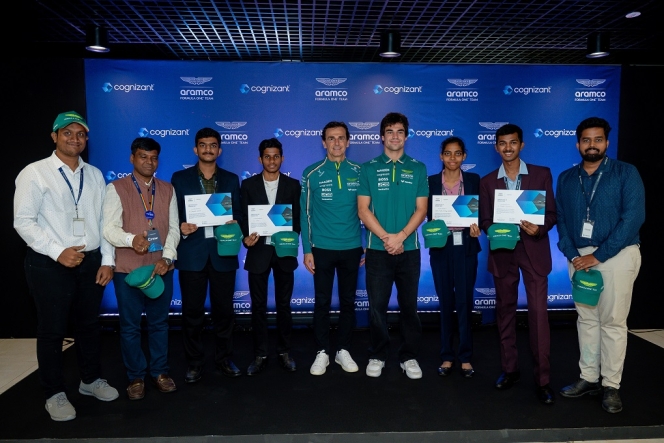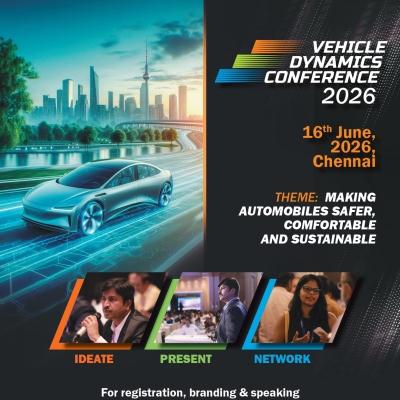VVDN Inaugurates Global Innovation Park
- By MT Bureau
- July 02, 2020
VVDN Technologies’ new Global Innovation Park (GIP) in Manesar goes live. The new facility will increase its current capacity multifold for electronic product engineering and manufacturing for a wide range of innovative versatile solutions including 5G Equipment, Trackers, Dashcams, Cameras, Wi-Fi Access Points.
Inaugurating the facility via video conference, the Union Minister for Road Transport & Highways, Shipping and Micro, Small and Medium Enterprises, Nitin Gadkari, said, "It is an achievement for Government of India's vision for an 'Atamanirbhar Bharat' when Indian Tech companies like VVDN take on the challenge of Designing and Manufacturing high-tech electronic products and components in India and set their eyes for global success."
Stating VVDN as a success story, Minister highlighted the need for import substitution, cost effective, pollution free, indigenous product manufacturing in India. He added that VVDN's Global Innovation Park, where under one roof all facilities of international standard designing, testing laboratories and production basis international standards will be done is futuristic and the way forward.
Spread across 10 Acres, VVDN's GIP is marked with R&D and electronic manufacturing facility. It is one-of-its-kind of facilities in India which has the capacity to accommodate 100,000 people over the next three years. VVDN Technologies was founded in 2007, with an aim to provide excellent engineering and manufacturing services to its customers. Since then company has been working on next generation technology innovation and have set up R&D centers across India as well as best in class manufacturing facilities in Manesar. With the new GIP facility, VVDN will have a multifold increase in its current capacity for electronic product engineering and manufacturing for a wide range of innovative versatile solutions including 5G Equipment, Trackers, Dashcams, Cameras, Wi-Fi Access Points.
Bhupender Saharan, CEO, VVDN, said, "The inauguration of GIP is an important milestone in the company's ongoing efforts to help India emerge as a hub of engineering innovation excellence and robust manufacturing. This Global Innovation Park, along with 10 other R&D centers, four manufacturing facilities across the country, will help us to continuously innovate on the latest technologies especially in the 5G, Wifi, Cloud, Vision IoT space. Having put down our roots so strongly in India, VVDN now is at a place where we would be able to scale up our deliveries for our domestic and global customers. This aligns with the company's effort to increase the employment in India and eventually contributing in providing a positive impact on the economy of our country." (MT)
AJAX Engineering Deploys AI-Based Personalised Video To Support Dealer Network
- By MT Bureau
- October 09, 2025

AJAX Engineering, a leading manufacturer in the construction equipment sector, has begun trialling a new method of connecting digital sales leads with its dealer network using personalised video messages. The project uses the IMPACT platform from AiVANTA to automate the process.
The initiative addresses the challenge dealers face in converting online inquiries, which often lack context. AJAX now sends each incoming lead a short, automated video containing the customer's name, the product they are interested in and contact details for the closest dealer, including a Google Maps link. The videos are available in regional languages and offer quick actions such as calling the dealer, booking a demonstration, or requesting details.
Delivered immediately via WhatsApp and email, the videos allow dealers to respond to customers with context. Early results indicate the communication can improve conversion rates from leads and increase visits to dealerships.
Karan Ahuja, Co-founder and CEO, AiVANTA, said, "Our collaboration with AJAX Engineering demonstrates how personalized, tailored video communication can transform dealer ecosystems. By bringing personalisation and regional accessibility into the lead journey, we are helping OEMs and dealers work in closer alignment to serve customers better."
The move by AJAX reflects a growing trend in dealer-led industries to use digital engagement tools to support physical interactions. By linking online inquiries and dealership visits, AJAX intends to improve customer experience and help dealers achieve sales outcomes.
Ansys Partners With Maker Bhavan Foundation To Boost STEM Education In India
- By MT Bureau
- October 08, 2025

Ansys, now part of Synopsys, has formed a strategic partnership with the US-based non-profit Maker Bhavan Foundation (MBF) to enhance STEM education for students at Tier-2 engineering colleges in India.
The collaboration will grant students in MBF’s Tinkerers’ Labs – the supported makerspaces – access to cutting-edge simulation tools from Synopsys’ Simulation and Analysis portfolio, alongside the Ansys Learning Hub. This initiative is specifically designed to provide students in these institutions with resources that match those available at top-tier engineering colleges.
Under the new Synopsys-MBF Simulation Education Program, students and faculty at up to six selected institutions will initially receive academic teaching licences for Ansys' multiphysics simulation solutions.
Damayanti Bhattacharya, CEO, Maker Bhavan Foundation, said, “This collaboration levels the playing field for students who might otherwise be overlooked. Each lab equipped with world-class tools is a promise to these young engineers that innovation has no boundaries of geography or privilege.”
Beyond providing software, Ansys will offer technical mentorship, coordinate hackathons and workshops and support training for both faculty and students. MBF will manage the implementation, acting as the liaison between the institutions and Synopsys to ensure effective tool usage and track learning outcomes.
Mike Yeager, Area Vice-President, India and Japan, at Ansys, part of Synopsys, said, “We are proud to partner with MBF in building a strong talent pipeline for the future. By bringing global technology to local classrooms, we are empowering students in India to innovate and solve real-world problems.”
This initial one-year partnership is viewed as the start of a long-term plan, with both Synopsys and MBF intending to extend the engagement to more institutions if successful, thereby increasing the impact on India’s innovation ecosystem.
- Traffic Infratech
- Road Infratech
- Parking Infratech Expos
- Bharat Mandapam
- Raj Manek
- Messe Frankfurt Asia Holdings
- Centre for Development of Advanced Computing
- International Centre for Automotive Technology
- Jayprakash Nair
Asia’s Largest Traffic And Mobility Expo Opens In Delhi
- By MT Bureau
- October 07, 2025

Asia’s largest integrated platform for traffic management, road construction and smart mobility solutions officially opened its doors today at the Bharat Mandapam, New Delhi. The combined Traffic Infratech Expo, Road Infratech Expo and Parking Infratech Expo are showcasing over 300 brands under the theme ‘Enabling Responsible Infrastructure and Mobility.’
The 2025 edition emphasises innovation, sustainability and collaboration, bringing together government officials, industry leaders and technology providers to address India’s rapidly evolving infrastructure needs.
Raj Manek, Executive Director & Board Member, Messe Frankfurt Asia Holdings, said, “At Messe Frankfurt India, our commitment to create platforms that don’t just showcase technologies but actively drive industry conversations and policy alignment. Traffic Infratech Expo has evolved into an ecosystem where government, industry leaders and innovators converge to shape the future of mobility. This year’s edition, with its scale and focus on responsible infrastructure, reflects India’s ambition to lead in safe, sustainable and technology-driven transport solutions.”
A key focus of the expo is ‘Transforming Transportation for the Future,’ with several high-level discussions planned on supporting home-grown technology solutions.
The event will host a significant Memorandum of Understanding (MoU) signing between the Centre for Development of Advanced Computing (CDAC) and the International Centre for Automotive Technology (ICAT) to accelerate indigenous technology development within the automotive sector.
Jayprakash Nair, Managing Director, Virtual Info System (VIS Group), said, “Over the years, Traffic Infratech Expo has become a catalyst for change in India’s transport and mobility landscape. Together with Messe Frankfurt India, we have built a platform that drives industry and government collaboration. Technology providers, product manufacturers, government associations, infrastructure, and policymakers are converging at the expo to discuss the real challenges and solutions needed. The 2025 edition is particularly significant as it not only introduces next-gen product categories but also brings multiple agencies and stakeholders to the table, reinforcing the show’s role as a driver of innovation and progress.”
The expo is supported by several key government bodies, including the Ministry of Road Transport and Highways (MoRTH) and the National Highways Authority of India (NHAI), and will feature the Smart Mobility Conference to enable in-depth policy discussions. The two-day event is set to host over 20 new product launches and facilitate B2B and B2G networking.
Aston Martin Aramco Formula One Team’s Lance Stroll Visits Cognizant Campus In Hyderabad
- By MT Bureau
- October 06, 2025

Cognizant hosted Aston Martin Aramco Formula One Team driver Lance Stroll and driver ambassador Pedro de la Rosa at its GAR campus in Hyderabad. The visit was part of 'Celebrating Cognizant', a series of sporting and cultural activities for company associates.
Lance and Pedro met with Cognizant’s leadership team and hundreds of associates, discussing how Cognizant’s digital expertise supports the team, especially ahead of the 2026 regulations.
Lance Stroll, said, "It was a pleasure to visit the Cognizant offices in Hyderabad and meet so many of the team. Hearing first-hand about Cognizant’s technology and services was valuable and we felt incredibly welcomed by everyone we met.”
Rajesh Varrier, President – Global Operations and Chairman & Managing Director, Cognizant India, said, “Today’s celebration with Lance is a proud moment for our associates and a powerful reminder of how far we have come in shaping the future of the Aston Martin Aramco Formula One Team through innovation. I am inspired by what we have achieved together and optimistic about the promise this partnership holds for the future.”
A fireside chat with Lance, Pedro, and Rajesh underscored the role of technology in F1 and the Cognizant partnership. The drivers engaged with associates in a Q&A session.
In addition to the visit, Cognizant hosted a virtual hackathon for nine teams from three organisations supported by its Outreach programme. Participants developed low-code or code-based solutions to make the team’s Ai.lonso avatar into an engaging digital companion for fans. The top two teams won cash prizes and met Lance and Pedro.
Cognizant began its partnership with the Aston Martin Aramco Formula One Team in 2021. The technology company acts as the team’s digital transformation partner, improving IT infrastructure and daily operations.






Comments (0)
ADD COMMENT